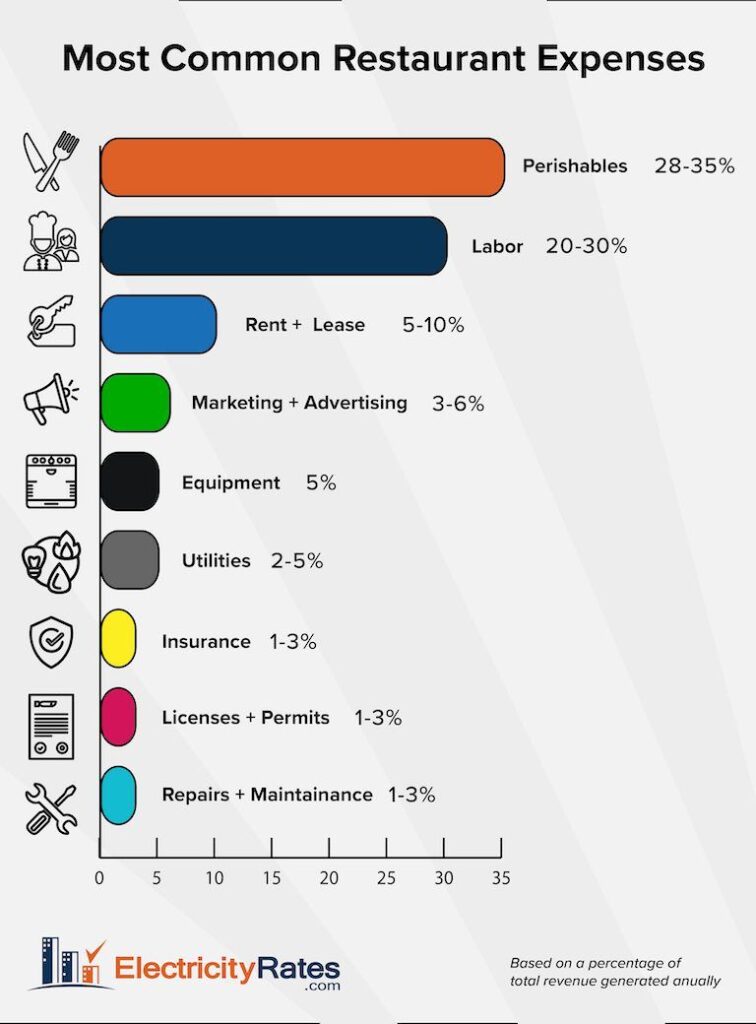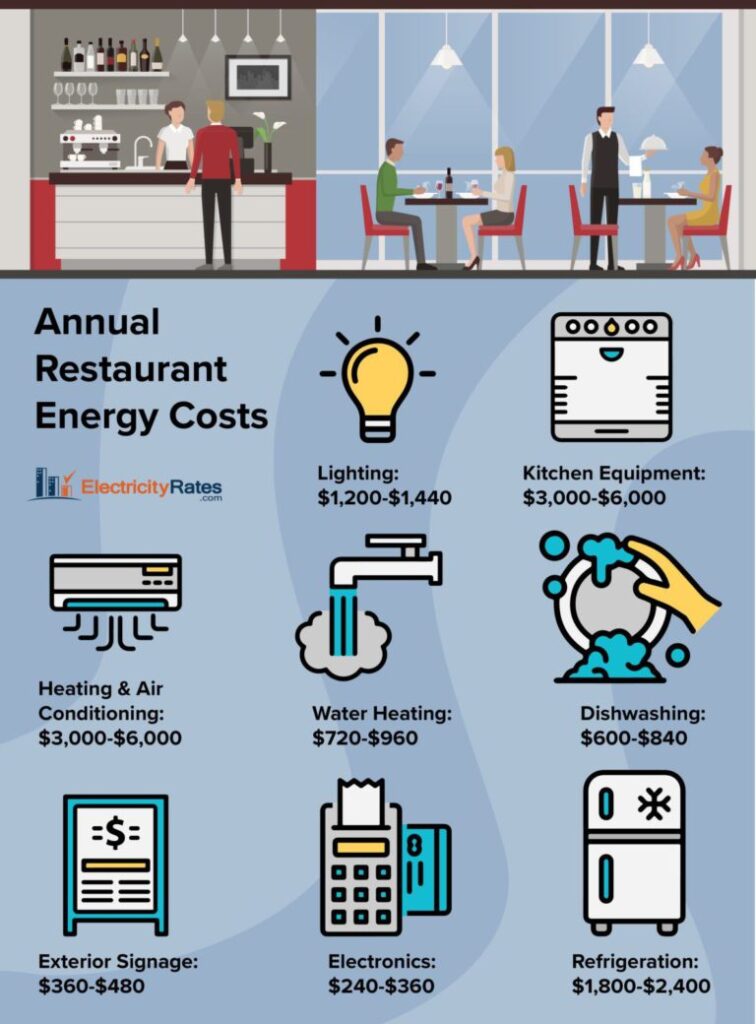The browser you are using is not supported. Please consider using a modern browser.

How to Save Money on Restaurant Operating Expenses
Table of Contents

Running a successful restaurant is no easy feat. It requires hard work, a loyal customer base, and financial investments to thrive – especially in today’s economic climate.
Food and beverage price inflation, plus rising labor costs, make profit margins for restaurants razor-thin. There are many operation factors for a restaurant entrepreneur to consider. Knowing how you stack up against average industry operating costs is key to finding the best areas to save big money.
In this article, we explore one of the most significant expenditure areas restauranteurs actually have control over – energy. Let’s start saving on your restaurant overhead now.
Overview of Restaurant Business Expenses
Restaurant industry expenses consist of fixed costs and variable costs.
Fixed Restaurant Costs:
These are costs that do not change with a restaurant’s rising or declining level of sales. Fixed costs are part of a restaurant’s operations, and the restaurant owner must take these into account. Fixed costs do not fluctuate over the short term or as a restaurant’s sales increase or decrease.
Fixed costs are expenses a restaurant must pay – rent and manager salaries. You must pay these regardless of the amount of food or products sold.
Variable Restaurant Costs:
Variable costs change based on how many sales a restaurant makes. A variable cost example is the cost of goods sold.
Say, a restaurant’s food cost is 33%. This means $0.33 is deducted from every dollar made in sales. If the sale of those food menu items does not happen, that variable cost is avoided, but so is the revenue. Another example is total labor cost. The more customers you serve, the more hourly employees you will need.
Restaurant expenses extend far beyond the purchase of raw ingredients and labor costs. Here is a restaurant business cost breakdown of the most common restaurant operating expenses.

- Food and Beverage Cost: A restaurant’s food and beverage cost is about 28-35% of total revenue. These costs include meal ingredients, liquor, and other food-related expenses.
- Labor Cost: This is another significant expense for restaurants, typically accounting for between 20-30% of total revenue. Labor costs encompass salaries for chefs, waitstaff, and other employees.
- Restaurant Equipment: this can make up to 5% of a restaurant’s initial expenses. On average, it costs $100,000 to $300,000, depending on the type of equipment.
- Rent and Lease Expenses: This varies greatly depending on the restaurant’s location. It can range from 5-10% of total revenue.
- Marketing and Advertising Costs: These costs amount to 3-6% of total revenue. This includes expenses for promotional materials, advertising campaigns, and social media or digital marketing efforts.
- Utilities: Utility costs for restaurants, including electricity, gas, water, and waste disposal, generally range from 2-5% of total revenue.
- Maintenance and Repairs: These costs can range from 1-3% of total revenue. They include expenses for equipment repairs, building maintenance, and other related costs.
- Insurance: Restaurant business insurance costs are typically around 1-3% of total revenue. This includes liability insurance, worker’s compensation, and property insurance.
- Licenses and Permits: The cost to start a restaurant business require paying for licenses and permits. The amount will vary depending on local regulations. But, usually makeup roughly 1-2% of total revenue.
Overview of Restaurant Energy Costs
Restaurants in the U.S. have one of the greatest energy intensities of any commercial building. This includes heating and cooling the building as well as cooking and refrigerating food.
Average restaurant electricity costs vary based on size and location. According to the U.S. Energy Information Administration (EIA), the electrical cost per square foot in a restaurant is an average of $2.90 annually. The estimated yearly energy cost for a mid-sized, 3,000-square-foot restaurant is $9,270.
It’s essential to understand what makes up the various energy costs. The biggest energy consumers in a restaurant are heating, ventilation, air conditioning (HVAC), lighting, and cooking equipment. HVAC can account for up to 40 percent of energy use alone.

- Kitchen Equipment: The heart of any restaurant, kitchen equipment like ovens, grills, and deep fryers, consume a significant amount of energy. They use between 25,000 to 30,000 kilowatt-hours (kWh) per year, costing about $3,000-$3,600 annually.
- Refrigeration: Walk-in coolers, freezers, and other refrigeration devices use about 15,000 to 20,000 kWh annually. This can account for an approximate yearly cost of $1,800-$2,400.
- Heating and Air Conditioning (HVAC): Controlling the restaurant’s temperature is a constant energy drain. It uses an average of 25,000 to 30,000 kWh per year, costing around $3,000-$3,600 annually.
- Lighting: Lighting typically uses between 10,000 to 12,000 kWh per year, costing approximately $1,200-$1,440 annually.
- Dishwashing: Commercial dishwashers can use up to 5,000 to 7,000 kWh per year, equating to about $600-$840 annually.
- Electronics: Cash registers, POS systems, music systems, etc., use around 2,000 to 3,000 kWh annually, costing about $240-$360 annually.
- Water Heating: Hot water for dishwashing and restrooms typically costs around 6,000 to 8,000 kWh per year, about $720-$960 annually.
- Exterior Signage: Depending on the size and type, exterior signs can consume about 3,000 to 4,000 kWh per year. This costs restaurants between $360-$480 annually.
Run a small business that isn’t a restaurant? Discover how to reduce your energy bill.
How to Reduce Cost in Your Restaurant Business
Owners often overlook energy and utility expenses as areas to save money. However, they are significant areas of expenditure where restaurants should introduce energy efficiency measures to affect profitability.
Monitor Your Restaurant’s Energy Usage
An energy audit is the first step to slashing the cost of running your restaurant business. Take a look at your previous monthly utility bills and energy usage patterns. This information will help determine where the restaurant is consuming the most energy.
By monitoring usage spikes, you can significantly reduce the electricity cost for your restaurant.
Implement Energy Use Protocols
Encourage your team to turn off devices during peak energy or when not used. Educate employees about energy usage efficiency and its effect on the environment and the business’s bottom line. Reward them for following energy-efficient guidelines at work.
Maintain Kitchen Equipment
Cooking equipment is notorious for being a top electricity hog. It makes up over half of the total electricity usage in most restaurants.
Regularly schedule equipment maintenance. Outdated or broken equipment can really hurt your electric bill. Installing energy-efficient cooking equipment can save up to 30 percent on your restaurant’s utility bills.
Restaurant Lightning Energy and Cost Savings
Switching to LED bulbs can save up to 90 percent of total lighting energy costs. Consider LEDs in the kitchen, signage, and even the parking lot for maximum savings.
In dining areas where bright LEDs may not be desirable, replace incandescent bulbs with compact fluorescent lamps (CFLs). CFLs save energy and last much longer. In a National Grid report, one restaurant owner replaced 20 standard bulbs with CFLs. Saving more than $400 per year.
Restaurant Water Energy and Cost Savings
According to the U.S. Environmental Protection Agency, food service facilities use 2.5X more water per square foot than other commercial facilities.
Restaurants can conserve water with multiple strategies. Reduce dishwasher water usage, install low-flow toilets and faucets, and regularly check for leaks.
See our guide for more ways to reduce costs by reducing restaurant waste.
Restaurant Energy and Cost-Saving Programs
Restaurants can also benefit from participating in energy efficiency programs. Check with your utility company, as many offer incentives for energy-efficient equipment, building improvements, and on-site renewable energy generation.
The U.S. Department of Energy also provides incentives and grants to each state to meet their energy efficiency goals. You can see if you qualify on the DOE website. These programs can significantly impact utility bills and can also help meet sustainability goals. You can also apply to become an Energy Star Certified Partner to benefit from free co-branding material and energy-saving resources.
Read our article for more ways to reduce energy expenditure and costs in your restaurant.
Choose a Cost-Effective Commercial Energy Provider
Choose an electrical supply company with a positive review record, dependable customer service, and a competitive energy plan price. Find your best option in our commercial Energy marketplace, where you can easily compare top-vetted options.
How Restaurants Can Save Money on Their Electricity Bills Takeaways
Energy is a significant expense for restaurants and can account for over 10 percent of total operating expenses. Restaurants can save money by understanding energy expenses and taking deliberate action to use less. Upgrade equipment, manage water usage, participate in energy-saving programs, and monitor utility bills. You can cut the average cost of restaurant electricity per month by signing up for a business electricity plan and lock in a low fixed rate. Check out our marketplace to shop and compare leading providers in your area.
Prioritize energy efficiency. Not only will it save you money, but it also contributes to a cleaner environment and attracts eco-conscious clientele.
